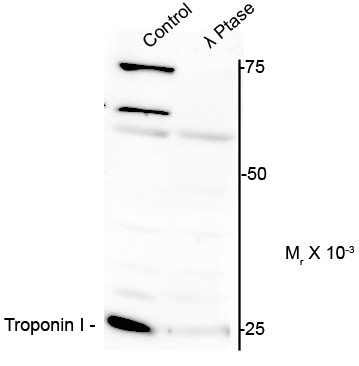Phospho-Ser150 Troponin I (cardiac) Antibody
Affinity purified rabbit polyclonal antibody
- SPECIFICATION
- CITATIONS
- PROTOCOLS
- BACKGROUND

Application
| WB |
|---|---|
| Primary Accession | P48787 |
| Reactivity | Mouse, Rat |
| Predicted | Human, Monkey |
| Host | Rabbit |
| Clonality | polyclonal |
| Calculated MW | 25 KDa |
| Gene ID | 21954 |
|---|---|
| Gene Name | TNNI3 |
| Other Names | Troponin I, cardiac muscle, Cardiac troponin I, Tnni3 |
| Target/Specificity | Synthetic phospho-peptide corresponding to amino acid residues surrounding Ser150 conjugated to KLH. |
| Dilution | WB~~ 1:1000 |
| Format | Prepared from rabbit serum by affinity purification via sequential chromatography on phospho- and dephospho-peptide affinity columns. |
| Antibody Specificity | Specific for the ~25k cardiac troponin I protein phosphorylated at Ser150. Immunolabeling is greatly decreased with lambda-phosphatase treatment. |
| Storage | Maintain refrigerated at 2-8°C for up to 6 months. For long term storage store at -20°C in small aliquots to prevent freeze-thaw cycles. |
| Precautions | Phospho-Ser150 Troponin I (cardiac) Antibody is for research use only and not for use in diagnostic or therapeutic procedures. |
| Shipping | Blue Ice |

Thousands of laboratories across the world have published research that depended on the performance of antibodies from Abcepta to advance their research. Check out links to articles that cite our products in major peer-reviewed journals, organized by research category.
info@abcepta.com, and receive a free "I Love Antibodies" mug.
Provided below are standard protocols that you may find useful for product applications.
Background
Troponin I (TnI) is 1 of 3 subunits, along with troponin C (TnC) and Troponin T (TnT) of troponin complex found in cardiac (cTnI) and fast skeletal (fsTnI) muscle. cTnI is phosphorylated by protein kinase C and protein kinase A at Ser23/24 (Noland et al, 1995) and is phosphorylated by AMPK at Ser23 and Ser150 (Solis et al, 2011). Evidence suggests that AMPK, a critical regulator of cardiac energetics, prefers phosphorylating Ser150 over Ser23, and may play a role in regulating energy consumption through altering the phosphorylation status of cTnI (Solis et al., 2011).
References
Raquel Sancho Solis, Ying Ge, Jeffery W. Wlaker. (2011) A Preferred AMPK phosphorylation site adjacent to the inhibitory loop of cardiac and skeletal Troponin I.
Thomas A. Noland, Jr., Xiaodu Guo, Robert L. Raynor, Nathan M. Jideama, Vera Averyhart-Fullard, R. John Solaro, and J.F. Kuo (1995) Cardiac Troponin I Mutants. J of Biol Chem 270 (43): 25445-25454.
If you have used an Abcepta product and would like to share how it has performed, please click on the "Submit Review" button and provide the requested information. Our staff will examine and post your review and contact you if needed.
If you have any additional inquiries please email technical services at tech@abcepta.com.













 Foundational characteristics of cancer include proliferation, angiogenesis, migration, evasion of apoptosis, and cellular immortality. Find key markers for these cellular processes and antibodies to detect them.
Foundational characteristics of cancer include proliferation, angiogenesis, migration, evasion of apoptosis, and cellular immortality. Find key markers for these cellular processes and antibodies to detect them. The SUMOplot™ Analysis Program predicts and scores sumoylation sites in your protein. SUMOylation is a post-translational modification involved in various cellular processes, such as nuclear-cytosolic transport, transcriptional regulation, apoptosis, protein stability, response to stress, and progression through the cell cycle.
The SUMOplot™ Analysis Program predicts and scores sumoylation sites in your protein. SUMOylation is a post-translational modification involved in various cellular processes, such as nuclear-cytosolic transport, transcriptional regulation, apoptosis, protein stability, response to stress, and progression through the cell cycle. The Autophagy Receptor Motif Plotter predicts and scores autophagy receptor binding sites in your protein. Identifying proteins connected to this pathway is critical to understanding the role of autophagy in physiological as well as pathological processes such as development, differentiation, neurodegenerative diseases, stress, infection, and cancer.
The Autophagy Receptor Motif Plotter predicts and scores autophagy receptor binding sites in your protein. Identifying proteins connected to this pathway is critical to understanding the role of autophagy in physiological as well as pathological processes such as development, differentiation, neurodegenerative diseases, stress, infection, and cancer.


